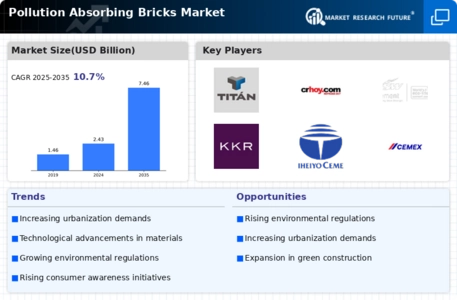Rising Construction Activities
The ongoing rise in construction activities across various sectors is a key driver for the Pollution Absorbing Bricks Market. With increasing investments in residential, commercial, and industrial projects, there is a growing need for materials that can address environmental concerns. Pollution-absorbing bricks offer a dual benefit: they provide structural integrity while also contributing to cleaner air quality. Data suggests that the construction sector is expected to witness a steady growth rate, with a significant portion of new projects focusing on sustainability. This trend is likely to propel the demand for pollution-absorbing bricks, as builders and developers seek to incorporate environmentally friendly solutions into their designs. The integration of these bricks into new construction not only meets regulatory requirements but also appeals to environmentally conscious consumers, thereby enhancing market potential.
Increasing Environmental Awareness
There is a notable rise in environmental awareness among consumers and builders, which is significantly influencing the Pollution Absorbing Bricks Market. As individuals become more conscious of their ecological footprint, the demand for sustainable construction materials has escalated. This shift in consumer behavior is prompting builders to seek out innovative solutions that not only meet aesthetic and structural requirements but also contribute positively to the environment. Surveys indicate that a substantial percentage of consumers are willing to pay a premium for eco-friendly building materials, including pollution-absorbing bricks. This trend suggests that the market is poised for growth as more stakeholders prioritize sustainability in their projects. The increasing emphasis on green building certifications further supports this driver, as pollution-absorbing bricks can help achieve these standards, thereby enhancing their appeal in the construction sector.
Government Initiatives and Policies
Government initiatives aimed at promoting sustainable construction practices are playing a crucial role in shaping the Pollution Absorbing Bricks Market. Various countries have implemented policies that encourage the use of eco-friendly materials in construction, including pollution-absorbing bricks. These initiatives often include financial incentives, tax breaks, and grants for projects that utilize sustainable materials. For instance, some regions have established regulations that mandate the use of pollution-reducing technologies in new buildings. Such policies not only stimulate demand for pollution-absorbing bricks but also create a favorable environment for manufacturers to innovate and expand their product lines. As governments continue to prioritize environmental sustainability, the market for pollution-absorbing bricks is expected to benefit from increased support and funding, further driving its growth.
Urbanization and Infrastructure Growth
The rapid pace of urbanization and infrastructure development is significantly impacting the Pollution Absorbing Bricks Market. As cities expand and populations grow, the need for sustainable building materials becomes increasingly critical. Urban areas are often characterized by high levels of air pollution, making the adoption of pollution-absorbing bricks a practical solution for mitigating environmental issues. The construction of new residential and commercial buildings presents a prime opportunity for integrating these innovative bricks into architectural designs. Market analyses suggest that the demand for pollution-absorbing bricks will rise in tandem with urban development projects, as builders seek to comply with environmental regulations and enhance the livability of urban spaces. This trend indicates a promising outlook for the market, as more construction projects incorporate pollution-absorbing technologies.
Technological Innovations in Material Science
The Pollution Absorbing Bricks Market is experiencing a surge in technological innovations that enhance the efficiency of pollution absorption. Advances in material science have led to the development of bricks that incorporate photocatalytic materials, which can effectively break down pollutants when exposed to light. This innovation not only improves air quality but also extends the lifespan of buildings. As urban areas continue to grapple with air pollution, the demand for such advanced bricks is likely to increase. Reports indicate that the market for pollution-absorbing materials is projected to grow at a compound annual growth rate of over 10% in the coming years, reflecting a robust interest in sustainable building solutions. Consequently, manufacturers are investing in research and development to create more effective pollution-absorbing bricks, thereby driving the market forward.


















Leave a Comment